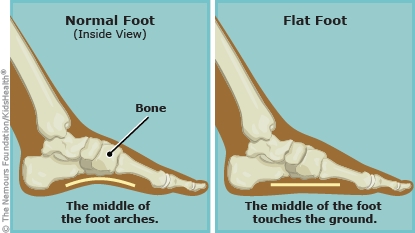- Parents Home
- Para Padres
- A to Z Dictionary
- Allergy Center
- Asthma
- Cancer
- Diabetes
- Diseases & Conditions
- Doctors & Hospitals
- Emotions & Behavior
- First Aid & Safety
- Flu (Influenza)
- Food Allergies
- General Health
- Growth & Development
- Heart Health & Conditions
- Homework Help Center
- Infections
- Newborn Care
- Nutrition & Fitness
- Play & Learn
- Pregnancy Center
- Preventing Premature Birth
- Q&A
- School & Family Life
- Sports Medicine
- Teens Home
- Para Adolescentes
- Asthma
- Be Your Best Self
- Body & Skin Care
- Cancer
- Diabetes
- Diseases & Conditions
- Drugs & Alcohol
- Flu (Influenza)
- Homework Help
- Infections
- Managing Your Weight
- Medical Care 101
- Mental Health
- Nutrition & Fitness
- Q&A
- Safety & First Aid
- School, Jobs, & Friends
- Sexual Health
- Sports Medicine
- Stress & Coping
Flat Feet
What Are Flat Feet?
Flat feet are feet that do not have an arch. The middle of the foot touches the ground.
What Are the Signs & Symptoms of Flat Feet?
Feet with no arches is the main sign of flat feet. Sometimes, flat feet can cause foot, ankle, or knee pain.
What Causes Flat Feet?
Most babies and toddlers have flat feet. As they grow, an arch usually develops. But in some people, the arch doesn’t form.
Flat feet can also be from:
- tight Achilles tendons (“tight heel cords”)
- muscle problems
- problems with how bones in the feet formed
Children with some kinds of genetic disorders (such as Down syndrome or osteogenesis imperfecta) can have flat feet. Flat feet can run in families.

What Are the Different Kinds of Flat Feet?
There are two kinds of flat feet:
- flexible flat feet: There’s no arch when the person walks, but there is an arch when they sit or stand on their tiptoes.
- rigid flat feet: There’s no arch when the person walks, sits, or stands on tiptoes.
How Are Flat Feet Diagnosed?
Doctors usually can diagnose flat feet by asking questions and doing an exam. If needed, they can order imaging studies, such as X-rays.
How Are Flat Feet Treated?
Flat feet that don’t cause problems usually need no treatment. Kids with flat feet should wear supportive, well-fitting shoes, but don’t need shoe inserts. They can do all the things that other children do.
Flat feet that cause pain or are linked to bone problems or tight tendons might need treatment. This could include shoe inserts to support the arch, physical therapy, special exercises, casting, or rarely, surgery. Kids with problems from flat feet usually need to see an orthopedic health care provider, who specializes in bones and joints.
When Should I Call the Doctor?
Call your doctor if:
- Your child has flat feet and develops foot, ankle, or knee pain.
- Your child has a normal arch and then develops flat feet.

© 1995- The Nemours Foundation. KidsHealth® is a registered trademark of The Nemours Foundation. All rights reserved.
Images sourced by The Nemours Foundation and Getty Images.



